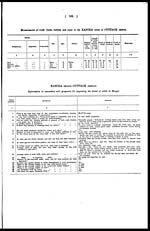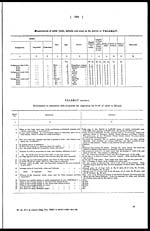Medicine - Veterinary > Civil Veterinary Departments > 1895-1951 - Annual report of the Civil Veterinary Department, Bengal > 1897-1898 - Annual report of the Civil Veterinary Department, Bengal, for the year 1897-98 > Annual report of the Civil Veterinary Department, Bengal, for the year 1897-98
(238) Page 192
Download files
Individual page:
Thumbnail gallery: Grid view | List view

( 192 )
Measurements of cattle (bulk, bullocks and cows) in the SADAR subdivision of OUTTACK district.
BREED. |
Sex. |
Age. |
Colour. |
Height |
Length |
Girth at |
Girth of |
Girth of |
Remarks. |
|||||
Indigenous. |
Imported. |
Cross-bred. |
||||||||||||
1 |
2 |
3 |
4 |
5 |
6 |
7 |
8 |
9 |
10 |
11 |
12 |
|||
Yrs. M. |
Ft. |
In. |
Ft. |
In. |
Ft. |
In. |
Ins. |
Ins. |
||||||
Bull ... ... ... |
...... |
... |
Male ... |
3 14 |
White ... ... |
3 |
9½ |
3 |
4 |
4 |
7 |
11 |
8 |
|
Bullock ... ... |
...... |
... |
Do. |
... |
Black, &c. ... |
3 |
11½ |
3 |
1 |
4 |
11½ |
12 |
8 |
|
Cow ... ... ... |
...... |
... |
Female |
... |
...... |
3 |
5 |
2 |
9 |
4 |
2 |
10 |
7½ |
|
Information in connection with proposals for improving the breed of cattle in Bengal.
Serial |
Questions. |
Answers. |
1 |
2 |
3 |
1 |
What is the total land area of the subdivision (cultivated, grazing, and |
Total area of the subdivision, including Banki, is 806,239 acres, of which |
2 |
Is any land available on a Government estate or otherwise, and if so, |
Available in the Government estate of Banki and the ward's estate of |
3 |
How are cattle fed, whether stall-fed or grazed, or both ; and whether |
Cattle are generally grazed, but plough-bullocks and some such cows are |
4 |
Is grazing scarce or plentiful ? ... ... ... ... ... ... ... |
Grazing is generally available, but there is a tendency to scarcity in the |
5 |
Is there any scarcity of drinking-water for cattle? ... ... ... |
Drinking-water for cattle is always available, except in summer when the |
6 |
Are the cattle sheltered during the winter and rains? ... ... ... |
Yes, except in the daytime when they are allowed to graze in the fields. |
7 |
Number of bulls in proportion to cows, and whether sufficient or not ? |
The number of bulls is at most 4 per cent., the general proportion being |
8 |
Do the calves have all the cows' milk ; if not, how much ? ... ... |
The calves have the whole of the milk for a month after their birth, after |
9 |
At what age are calves weaned, and how are they fed after weaning? |
The calves are weaned after a year generally, and then they live by |
10 |
At what age are bull-calves gelded, and when do they begin work ? ... |
Within one year of their birth and generally in the second half-year, |
11 |
Is odder stored for cattle, and if so, what does it comprise? ... |
Yes. Straw (nara and pala) of paddy is generally stored. The top part |
12 |
Average yield of milk, and how long after carvmg do the cows continue |
On an average § seer of milk. The period for which cows are milked varies |
13 |
Average price of local bulls, cows, and bullocks ... ... ... ... |
Bulls are not generally sold. The average price per cow is Rs. 8, and that |
14 |
Ditto of imported ditto ... ... ... ... |
Foreign cattle are not generally imported. In a few places their price is |
15 |
Whence do the imported cattle come, and for what purpose are they |
From the Madras Presidency, as they are stronger and better milkers. |
16 |
Is there any special system of cattle management in your subdivision ? |
No. |
17 |
What is the average height of the best bulls behind hump? ... |
4 feet 6 inches. |
18 |
What is the average height of the worst bulls behind hump? ... ... |
3 feet 9 inches. |
19 |
What is the average height of cows? ... ... ... ... .. |
4 feet. |
20 |
Are Brahmini bulls let loose? ... .. ... ... ... ... ... |
Yes. |
21 |
Are there too many Brahmini bulls? ... ... ... ... ... ... |
No. |
Set display mode to: Large image | Zoom image | Transcription
Images and transcriptions on this page, including medium image downloads, may be used under the Creative Commons Attribution 4.0 International Licence unless otherwise stated. ![]()
| Permanent URL | https://digital.nls.uk/76342122 |
|---|




